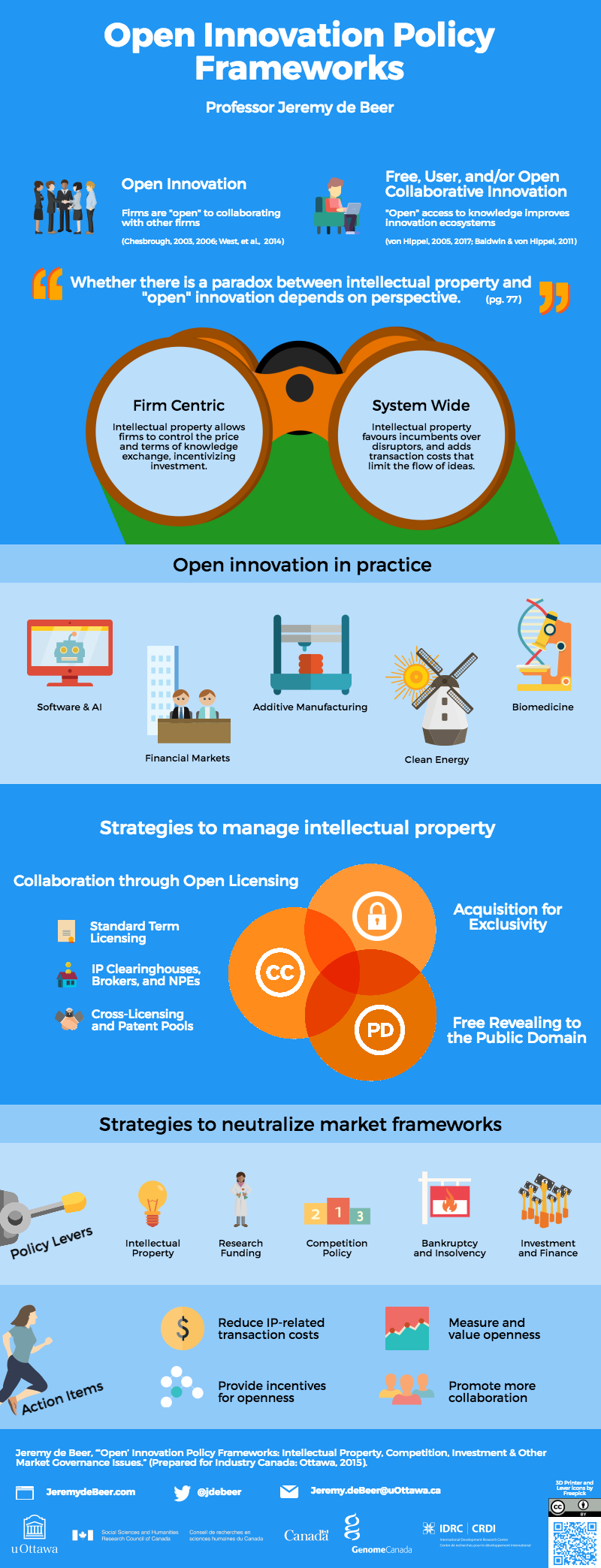The central objective of this study, prepared for Industry Canada, is to explain what “open” innovation is and how policymakers might respond to it.
More specifically, this study aims to:
- Clarify the meaning of terms describing new forms of innovation, with examples.
- Describe the relationship between open innovation and intellectual property (IP).
- Recommend appropriate IP and other marketplace framework policy measures.
An “innovation” is the implementation of a new or significantly improved product, process, marketing method, or organizational structure. Some people define “open innovation” from an individual firm’s perspective, meaning that innovation happens when knowledge flows into and out of the organization instead of being developed in-house. Others use terms like “open collaborative innovation,” “user innovation,” and “peer production,” to describe how a more fundamental change in the socio-economic systems that facilitate innovation.
The different ways that “open” is applied in the context of innovation and intellectual property is not just a matter of semantics or academic debate. It is crucial for innovation policymakers to recognize that different stakeholders, advisors, and organizations may use the same or similar terms inconsistently. The solution is not as simple as choosing one definition and sticking with that. Caution is warranted to ensure clear understanding of the various connotations of “open” innovation and the consequences for intellectual property and other marketplace framework policy areas.
Intellectual property can facilitate and frustrate knowledge exchange. Firms use various strategic IP management models to exploit innovation:
- Collaborating through open licensing. This strategy leverages the IP system, using standard form licenses, IP clearinghouses, license brokers, or even non-practicing entities.
- Acquisition toward commercialization. This is a closed strategy, in which formal IP rights are used to secure funding, limit competition, and/or raise prices.
- Free revealing knowledge to the public domain. This strategy may be used to solve collective problems, grow infant industries, exploit network effects, and/or sell complementary goods or services.
Policies should reduce the cost of knowledge exchanges. One of the key recommendations for marketplace framework policymakers is to neutralize marketplace framework policies to equally encourage and support open as well as proprietary innovation strategies. Implementing this recommendation may involve several steps. At least, policymakers should reduce the transaction costs of knowledge exchanges. This can be done by increasing the quality of formal IP rights, and by gathering and making available better IP-related data for private businesses and public policymakers to make decisions.

Suggested Citation: Jeremy de Beer, “‘Open’ Innovation Policy Frameworks: Intellectual Property, Competition, Investment & Other Market Governance Issues.” (Prepared for Industry Canada: Ottawa, 2015).
The Government of Canada funded this study via the Patent Policy Directorate of Industry Canada and the Canadian Intellectual Property Office. The opinions expressed do not necessarily reflect the views of the Government of Canada. Certain data and analysis is based upon complementary ongoing research funded by the Social Sciences and Humanities Research Council of Canada (SSHRC), and research previously funded by the International Development Research Centre and Genome Canada. The author gratefully acknowledges the research assistance of Sean Stidwill, Andrew Martinez, Enang Akan, and Samantha Santos.